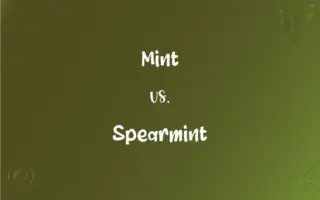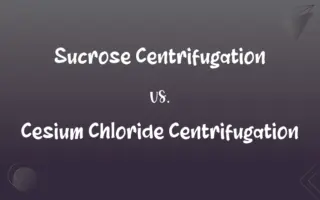Olefins vs. Paraffins: What's the Difference?
Edited by Aimie Carlson || By Janet White || Published on October 22, 2024
Olefins are hydrocarbons containing at least one double bond between carbon atoms, making them unsaturated, while paraffins are saturated hydrocarbons with single bonds only.

Key Differences
Olefins, also known as alkenes, are hydrocarbons that contain at least one carbon-carbon double bond, giving them distinctive chemical properties. Paraffins, in contrast, are saturated hydrocarbons, also known as alkanes, characterized by single bonds between carbon atoms. This structural difference fundamentally influences their chemical reactivity, with olefins being more reactive due to the double bond.
In terms of physical properties, olefins generally have lower boiling points than paraffins of similar molecular weight, due to their less saturated nature. Paraffins, being saturated, tend to have higher boiling points, making them less volatile compared to olefins. This difference in boiling points is a key factor in industrial processes such as distillation, where these hydrocarbons are separated and refined.
Olefins are known for their ability to participate in a variety of chemical reactions, such as polymerization and alkylation, due to the presence of a double bond. Paraffins, however, are relatively inert because of their saturated carbon chains, limiting their reactivity in comparison to olefins. This reactivity of olefins makes them valuable in the production of polymers and other chemicals.
In the petrochemical industry, olefins are crucial as feedstock for producing many chemicals and materials, including plastics, due to their reactive double bonds. Paraffins, on the other hand, are commonly used in applications requiring stable hydrocarbons, such as in lubricating oils and in the production of kerosene and diesel. The stability of paraffins also makes them preferable for long-term storage and transport.
Olefins can be produced through the cracking of larger hydrocarbon molecules, a process that breaks down larger paraffins and other hydrocarbons into smaller, more reactive olefins. Paraffins, being less reactive, are often the desired end-products in refining processes, where stability and low reactivity are advantageous. This difference in production and usage highlights the distinct roles olefins and paraffins play in the chemical and petrochemical industries.
ADVERTISEMENT
Comparison Chart
Chemical Bonds
Contain double bonds
Contain only single bonds
Saturation
Unsaturated hydrocarbons
Saturated hydrocarbons
Reactivity
More reactive
Less reactive
Boiling Points
Generally lower
Generally higher
Primary Uses
Used in polymer production
Used as fuels and in waxes
ADVERTISEMENT
Olefins and Paraffins Definitions
Olefins
Olefins are unsaturated hydrocarbons with one or more double bonds.
Ethylene, a commonly used olefin, is a key raw material in plastic manufacturing.
Paraffins
They are less reactive than olefins due to their saturation.
Paraffins are stable and don’t easily participate in chemical reactions.
Olefins
Olefins serve as a base for important industrial chemicals.
Propylene, an olefin, is converted into polypropylene for plastic production.
Paraffins
Paraffins are widely used in creating waxes and fuels.
Paraffin wax is used in candles and cosmetic products.
Olefins
Olefins are produced predominantly in the petrochemical industry.
The petrochemical industry produces olefins through steam cracking.
Paraffins
They have high melting and boiling points.
Long-chain paraffins are solid at room temperature due to their high melting points.
Olefins
They are characterized by their chemical reactivity due to double bonds.
Olefins are reactive and can be used in various chemical reactions.
Paraffins
Paraffins are saturated hydrocarbons with only single bonds.
Methane, the simplest paraffin, is a major component of natural gas.
Olefins
They are essential in making synthetic rubbers and lubricants.
Olefins are used in synthesizing certain types of rubber.
Paraffins
Paraffins are common in crude oil and natural gas.
Crude oil is refined to separate useful paraffins for various applications.
Olefins
Any of a class of unsaturated open-chain hydrocarbons having at least one double bond.
Paraffins
A waxy white or colorless solid hydrocarbon mixture used to make candles, wax paper, lubricants, and sealing materials. Also called paraffin wax.
Olefins
A fiber or fabric made of this material.
Paraffins
(Chemistry) A member of the alkane series.
Olefins
Plural of olefin
Paraffins
Chiefly British Kerosene.
Paraffins
To saturate, impregnate, or coat with paraffin.
Paraffins
Plural of paraffin
Paraffins
Infl of paraffin
FAQs
Are olefins found in nature?
Olefins are not common in nature and are mostly man-made.
How are olefins produced?
Olefins are mainly produced through petrochemical processes like steam cracking.
What makes olefins reactive?
The double bonds in olefins make them chemically reactive.
What are olefins?
Olefins are unsaturated hydrocarbons with double bonds.
Do paraffins have high boiling points?
Yes, paraffins generally have high boiling points.
Are paraffins soluble in water?
Paraffins are insoluble in water due to their non-polar nature.
How stable are paraffins?
Paraffins are quite stable due to their saturated single bonds.
Can olefins form polymers?
Yes, olefins are key in polymer production due to their double bonds.
Where are paraffins found?
Paraffins are abundant in crude oil and natural gas.
How do olefins and paraffins differ in structure?
Olefins have double bonds; paraffins have only single bonds.
Can olefins be converted into other chemicals?
Yes, olefins can be transformed into a variety of chemicals.
Are paraffins toxic?
Paraffins are generally non-toxic but depend on the specific compound.
What role do olefins play in the environment?
Olefins can contribute to air pollution and are part of industrial emissions.
What are paraffins used for?
Paraffins are used in fuels, waxes, and lubricants.
Do olefins occur in gasoline?
Olefins may be present in small amounts in gasoline.
What industrial sectors use olefins?
Olefins are widely used in the plastics, rubber, and chemical industries.
Are olefins environmentally friendly?
The production and use of some olefins can have environmental impacts.
Can paraffins be used in food?
Food-grade paraffins are used in coatings and packaging.
Is methane an olefin or a paraffin?
Methane is a paraffin, being the simplest alkane.
How are paraffins extracted?
Paraffins are extracted through refining of crude oil and natural gas processing.
About Author
Written by
Janet WhiteJanet White has been an esteemed writer and blogger for Difference Wiki. Holding a Master's degree in Science and Medical Journalism from the prestigious Boston University, she has consistently demonstrated her expertise and passion for her field. When she's not immersed in her work, Janet relishes her time exercising, delving into a good book, and cherishing moments with friends and family.
Edited by
Aimie CarlsonAimie Carlson, holding a master's degree in English literature, is a fervent English language enthusiast. She lends her writing talents to Difference Wiki, a prominent website that specializes in comparisons, offering readers insightful analyses that both captivate and inform.






























































